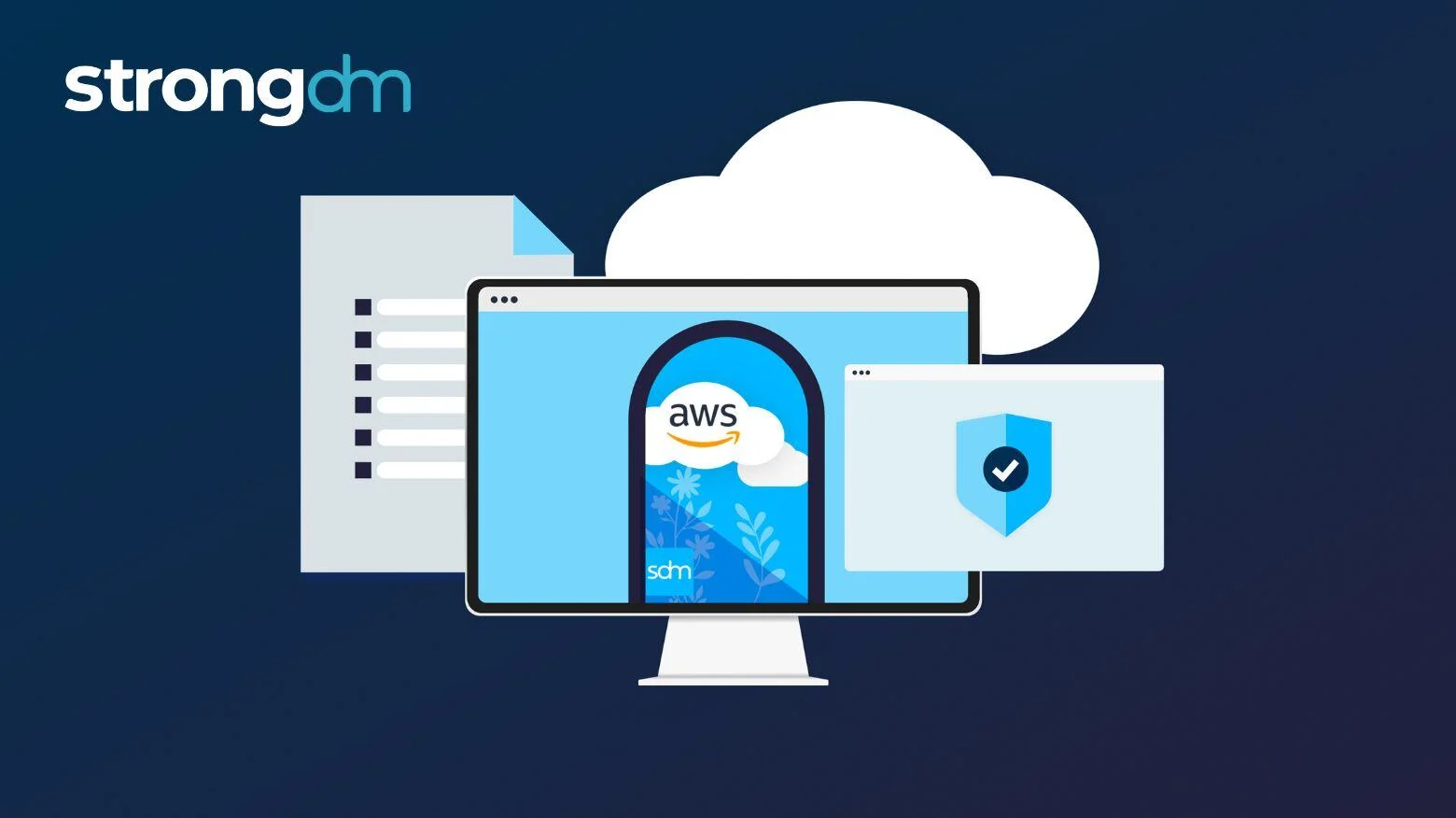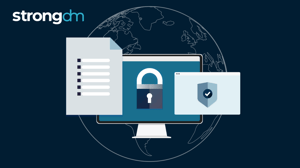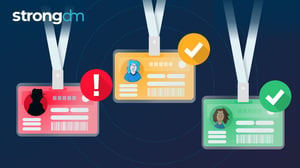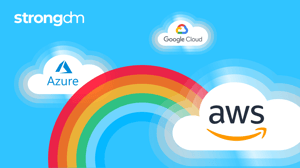
- Role-based, attribute-based, & just-in-time access to infrastructure
- Connect any person or service to any infrastructure, anywhere
- Logging like you've never seen

Achieving and maintaining compliance is no walk in the park - it’s more like trying to throw a ping pong ball across the Mississippi, against the wind, with your non-dominant hand.
The ephemeral nature of the cloud drives operational efficiency but can also present daunting challenges for security and audit teams striving to keep up. Continuous adherence to SOC 2, PCI, GDPR, and HIPAA controls is an always-on proposition, and compliance teams know the stakes are high. Protect data, control access, and keep everything audit-ready… all while managing a sprawling cloud environment that’s constantly shifting and scaling.
The real challenge lies in addressing two key issues:
- The dynamic nature of cloud infrastructures.
- The never-ending problem of configuration drift.
AWS environments bring dynamic change with every new EC2 instance, S3 bucket, and deployment. But drift–the deviation from intended configurations, usually caused by manual changes or poorly enforced access controls–can undo even the most carefully crafted compliance strategies. When infrastructure strays from its baseline, security gaps are created which puts compliance efforts and sensitive data at risk.
💡Make it easy: Enterprises seek ways to effectively address the needs of dynamic, always-evolving cloud infrastructures, and StrongDM has developed a platform that is designed with built-in capabilities to support continuous compliance in AWS environments. With StrongDM, compliance teams don’t need to sacrifice their weekends to endless policy tweaks and audit prep. Instead, they can take advantage of StrongDM’s automated access controls and audit trails which enable them to enforce tight, consistent security policies across AWS. Let’s take a closer look at how enterprises can stay ahead on compliance and be confidently ready to handle audits.
The Agony and The Ecstasy: The Reality of AWS Environments
Establishing consistent security policies in AWS is just the beginning. The real challenge isn’t in creating these policies, but in preserving them. Cloud environments are dynamic; they shift and evolve continuously and rapidly. While security teams that embrace immutable infrastructure practices usually seek a state of calm, issues inevitably arise the moment configuration drift enters the picture.
The Role of Access Control in Preventing Drift
And the reality is that drift ALWAYS finds a way in. It’s the human component, things like manual interventions, rushed changes, or overlooked best practices. When EC2 instances, S3 buckets, or RDS databases stray from their intended configurations, it’s quite often because access controls are weak, nonexistent, or poorly enforced. That’s the crux of the issue – access control isn’t just a security box to check, it’s the frame that keeps the whole compliance picture intact. Without it, that carefully constructed AWS environment can quickly become a mess of vulnerabilities and compliance nightmares.
The Demands of Compliance Audits
And don’t forget about audits—because they’ll never forget about you. Regular audits are part of the compliance continuum, and each one brings demands for detailed reporting on who accessed what, when, and how. Missing a piece of that story? Expect some uncomfortable conversations (and maybe a few extra late nights to gather more evidence).
The Consequences of Non-Compliance
Non-compliance is far more than a slap on the wrist; it can mean significant financial penalties, a deal your sales team couldn’t close, a serious hit to your company’s reputation, and heightened security risks that make your environment an easy target. When a single misstep can lead to a data breach or regulatory action, the stakes are high. Compliance measures are intended to reduce your risk, but achieving and maintaining compliance has never been more challenging.
How StrongDM Enables Consistent Security Policies in AWS
StrongDM's Zero Trust approach to enterprise privileged access not only ensures that enterprises operate under policies governing all aspects of user authentication, resource authorization, session management, and activity auditing but also addresses one of the most pressing challenges in cloud environments: configuration drift. By ensuring that only the right people access the right resources under the right conditions, every time, StrongDM eliminates the vulnerabilities introduced when infrastructure strays from intended configurations.
Automating Compliance
This level of precision significantly enhances compliance efforts by automating policy enforcement and providing detailed, real-time audit trails that effortlessly meet rigorous regulatory standards. With StrongDM, enterprises gain control over drift by tying every access decision directly to enforceable policies, reducing manual interventions and maintaining consistent security postures across dynamic environments.
Centralized Control
The platform enforces the principle of least privilege, granting users access only to the resources essential for their roles. This minimizes potential attack surfaces and mitigates risks caused by unauthorized changes to infrastructure. Centralized control is achieved by integrating authentication, authorization, networking, and observability into a single, cohesive platform. Administrators can define access policies that automatically apply across all AWS resources, regardless of scale, changes, or evolving configurations.
Uniform Policy-Based Access Control
This centralized policy engine ensures security policies remain consistent and enforceable, even as your AWS environment evolves. Supporting a wide range of AWS resources—including EC2 instances, RDS databases, and S3 buckets—StrongDM applies policy-based access control uniformly, helping enterprises address drift while meeting compliance requirements with confidence and ease.
The StrongDM PAM platform includes:
- Just-in-Time (JIT) Access: Grants temporary, time-bound access to resources, reducing the risk associated with standing privileges.
- Session Recording: Captures all user sessions for compliance and auditing purposes, providing a complete audit trail.
- Granular Role-Based Access Control (RBAC): Allows administrators to assign specific permissions based on user roles, ensuring users have appropriate access relevant to their job functions.
- Multi-Factor Authentication (MFA): Enhances security by requiring multiple forms of verification before granting access.
- Comprehensive Logging and Monitoring: Provides real-time visibility into user activities, aiding in proactive security measures and decision-making.
StrongDM leverages these capabilities to enforce consistent security policies across AWS environments, simplifying compliance and strengthening your organization’s overall security posture.
…That’s the crux of the issue – access control isn’t just a security box to check, it’s the frame that keeps the whole compliance picture intact..
Simplified Audits and Automated Compliance Reporting with StrongDM
For security teams, one of the most challenging aspects of compliance is generating detailed, accurate reports that demonstrate policy adherence and secure access management. StrongDM takes the manual work out of this process by providing automated, comprehensive audit trails, giving security and compliance professionals the real-time visibility they need to stay audit-ready.
Real-Time Logging and Comprehensive Audit Trails
Here’s how it works: StrongDM captures every access event in real time, logging who accessed what, when, and how. Whether users are accessing EC2 instances, RDS databases, S3 buckets, or other AWS resources, StrongDM records each interaction in precise detail. These activity logs provide a complete audit trail, which is crucial for maintaining compliance with frameworks like SOC 2, GDPR, HIPAA, and others.
Seamless Integration with AWS for Easy Reporting
StrongDM’s integration with AWS is seamless, allowing the platform to track and log all user activity without interrupting operations or adding complexity. Logs are exportable, making it easy to generate reports for internal reviews or external compliance audits. With data points covering the full access lifecycle—who requested access, the resource accessed, the session duration, and actions taken—auditors can get a transparent, verifiable view of your environment’s security.
Streamlining Audit Preparation with Automation
Automated logs and reports generated by StrongDM cut down on the manual work traditionally required to prepare for audits. Instead of spending days compiling access records, you can pull detailed reports with a few clicks. This not only saves significant time and effort but also improves response times when audit requests come in. Rather than sifting through disparate logs across multiple AWS services, StrongDM centralizes everything into a single, streamlined system, keeping audit preparation efficient and precise.
Ultimately, StrongDM ensures that compliance reporting isn’t a last-minute scramble but a natural part of your AWS security strategy, freeing up your team to focus on proactive measures and reducing the strain that audits typically bring.
Benefits of StrongDM for AWS Compliance
Using StrongDM in AWS environments provides important benefits that support enterprise compliance efforts. Here’s why StrongDM is the smart choice for maintaining compliance in the cloud:
1. Simplified Compliance Processes
With centralized, policy-based controls and automated audit trails, compliance becomes an integrated part of normal operations, not a last-minute scramble. Security teams can easily set and enforce access policies across all AWS resources, making sure that controls are applied consistently without endless manual updates. By automating policy application and audit trails, StrongDM significantly reduces the burden of maintaining compliance.
2. Reduced Risk of Human Error in Audits
Human error is often the biggest risk to achieving compliance goals. Manually compiling audit data and enforcing policies across various AWS resources creates opportunities for mistakes—whether it’s forgetting to log an access event, overlooking a configuration, or missing a policy update. StrongDM’s automated logging and centralized control eliminate these error-prone processes. Access policies apply automatically across the board, and detailed activity logs capture every user interaction, ensuring there are no gaps. This reduces the chance of errors that could otherwise lead to compliance violations or missed audit requirements.
3. Enhanced Security Posture Through Zero Trust Access Control
By enforcing the principle of least privilege, StrongDM ensures that users only have access to the specific AWS resources they need—nothing more, nothing less. This reduces the risk of unauthorized access and lateral movement within your cloud environment. Zero Trust access control also means that every access request is validated and recorded, creating a verifiable trail for compliance and strengthening your overall security posture.
4. Streamlined Audit Readiness with Automated Logs and Reporting
Automated logs capture who accessed what, when, and how in real time. These logs are exportable and ready to generate detailed, audit-ready reports at a moment’s notice. Instead of sifting through scattered logs across various AWS services, StrongDM’s centralized logging system consolidates everything in one place, enabling quick, efficient access to the information auditors need. The time savings are substantial, and it means you’re always ready for compliance checks.
A Smarter Way to Manage Compliance in AWS
For security and compliance professionals, StrongDM offers a smarter, more reliable way to meet AWS compliance standards. By simplifying compliance processes, minimizing human error, enforcing Zero Trust policies, and keeping audit preparation efficient, StrongDM allows teams to manage compliance with confidence and ease. If you’re ready to improve compliance management and meet industry standards effectively, it’s time to explore what StrongDM can do for your AWS environment.
Book a demo of StrongDM and see how our Zero Trust PAM platform can provide what your legacy systems can’t.
About the Author
John Martinez, Technical Evangelist, has had a long 30+ year career in systems engineering and architecture, but has spent the last 13+ years working on the Cloud, and specifically, Cloud Security. He's currently the Technical Evangelist at StrongDM, taking the message of Zero Trust Privileged Access Management (PAM) to the world. As a practitioner, he architected and created cloud automation, DevOps, and security and compliance solutions at Netflix and Adobe. He worked closely with customers at Evident.io, where he was telling the world about how cloud security should be done at conferences, meetups and customer sessions. Before coming to StrongDM, he lead an innovations and solutions team at Palo Alto Networks, working across many of the company's security products.

You May Also Like




